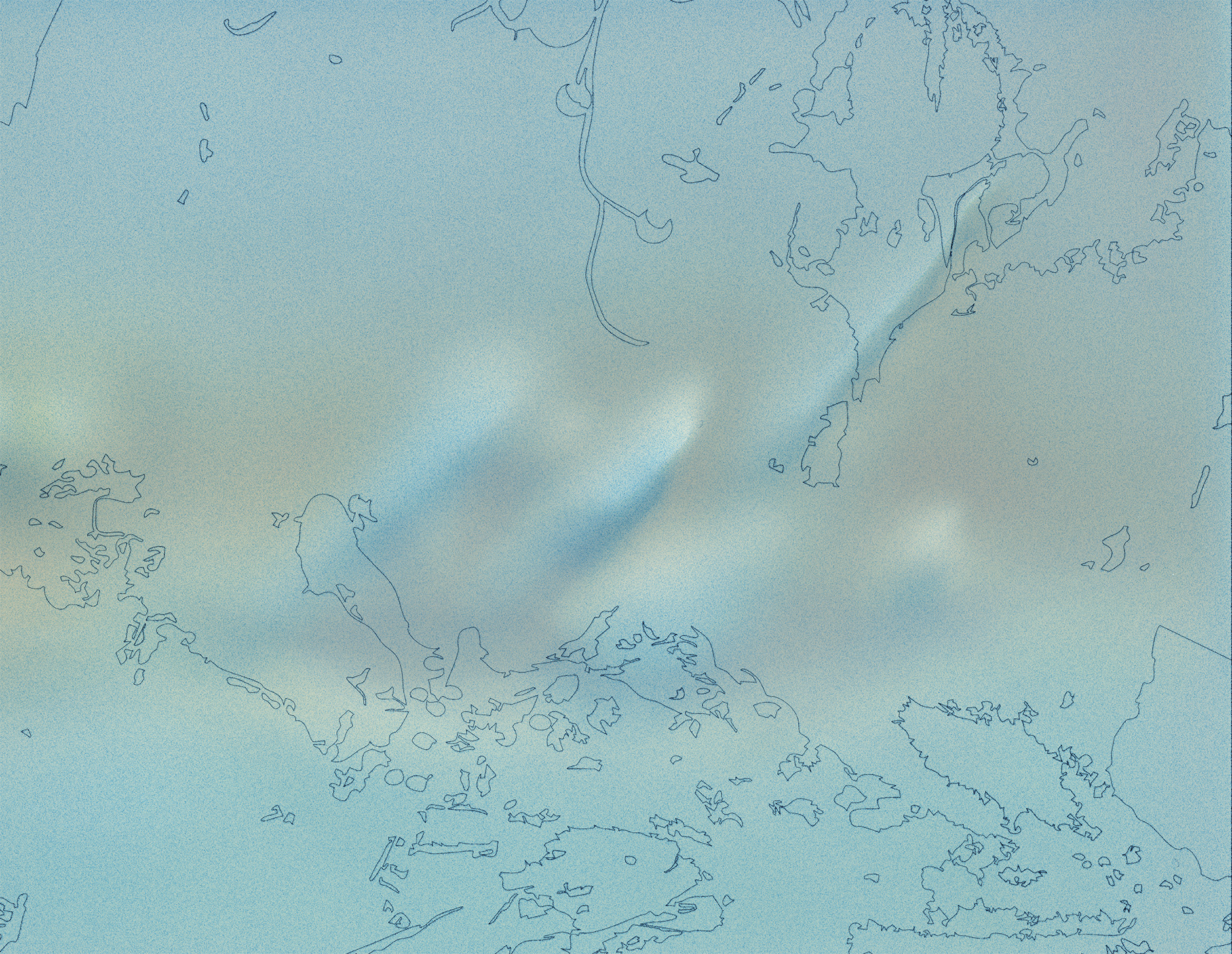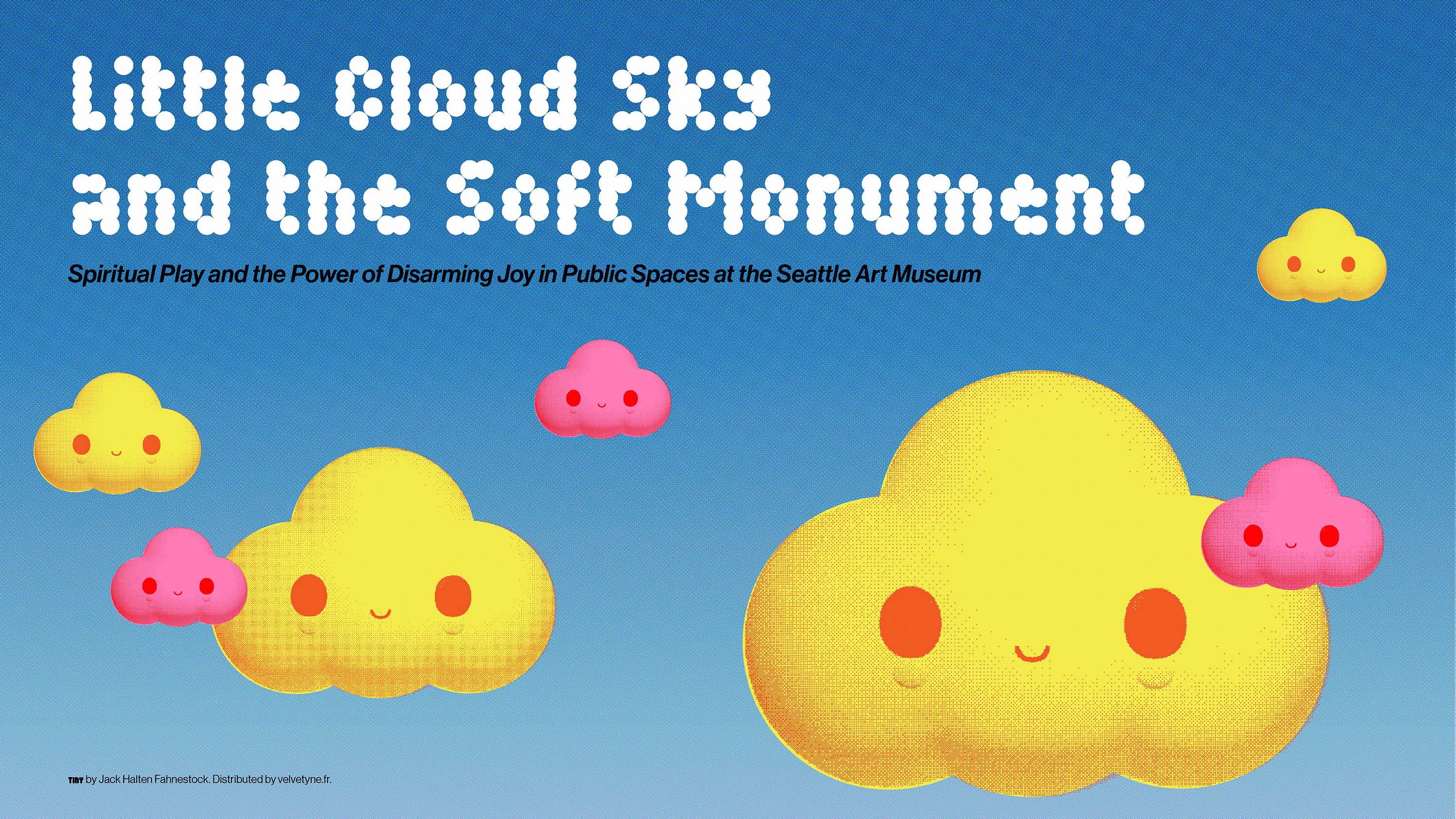
"Seattle is a city where clouds dominate the emotional landscape," said Jose Carlos Diaz, the Seattle Art Museum's Susan Brotman Deputy Director of Art, and head of the Brotman Forum transformation project. "I find those Seattleites comfortable with the weather." It's a quiet acknowledgment of the particular regional psyche — the overcast mood, the lush greenery and moody sky, diffused gray light, and wet introspection that many either endure or embrace in this Pacific Northwest terrain.
With Little Cloud Sky, the new installation by artist duo FriendsWithYou, the museum leans into that environmental stereotype, and floats above it. Installed in SAM's free-to-enter Forum space downtown, the piece is a field of serene, smiling clouds suspended from the ceiling, a dreamscape that exudes levity, childlike curiosity, and the soft power of welcome. It’s what FriendsWithYou calls a "soft monument." "The universe is here to help us," they share, a sentiment that resonates deeply in a region where rhythmic seasons shape our daily lives.
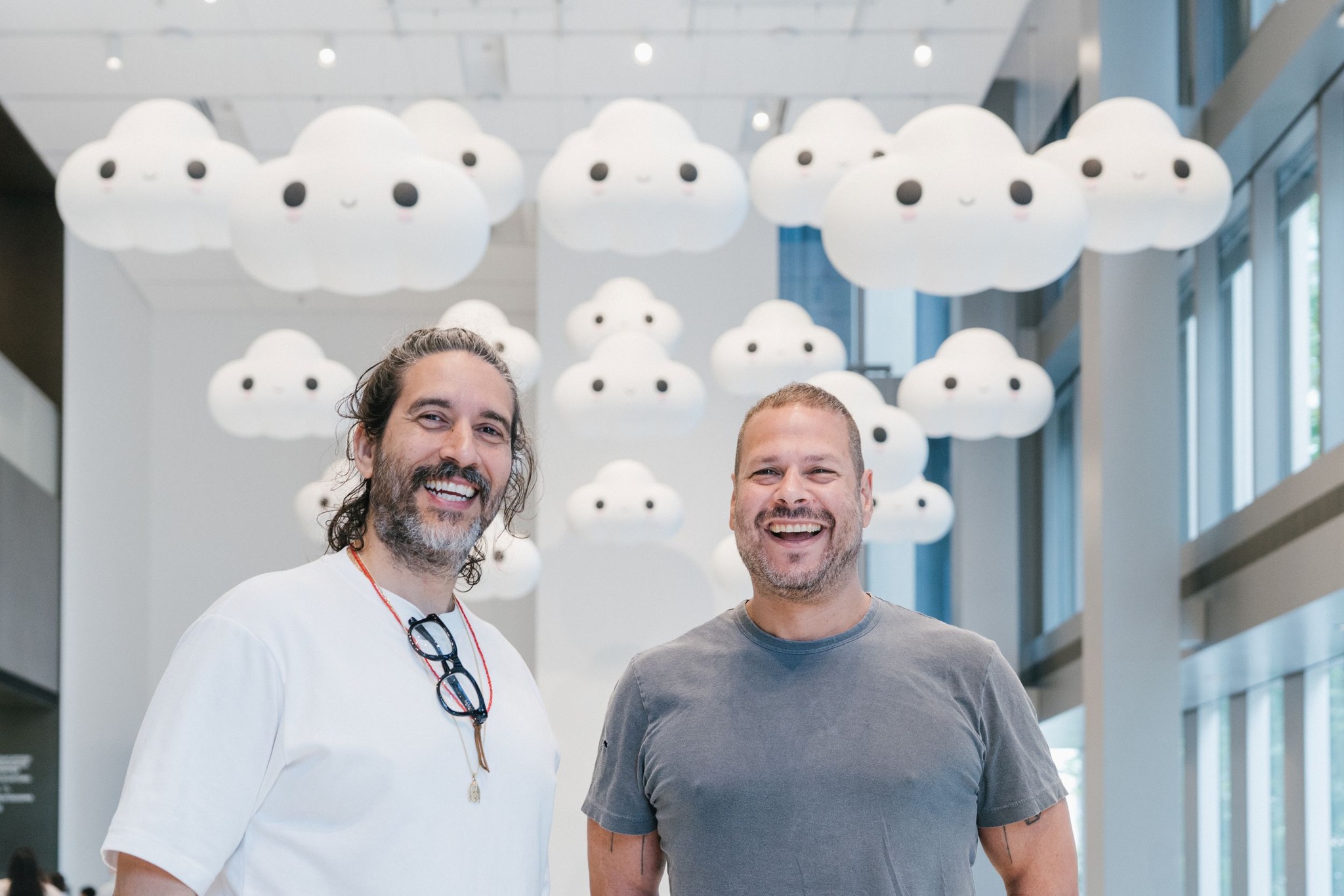
In this interview, we explore how Little Cloud Sky's work, with its nods to both Indigenous and universal cosmologies and its celebration of the Seattle sky, fosters a sense of community and environmental awareness.
The Seattle Art Museum commissioned Little Cloud Sky with the intent to rethink how the public enters and interacts with the museum space itself. “This is a public space,” Diaz said. “People don’t even need to know it’s a museum. They might just walk in, or pass through, but we wanted to give them something that emotionally anchors their visit — whether they stay for two minutes or two hours.”
In that sense, it is part of a broader strategy at SAM, one that includes a wide range of programmatic touchpoints: outdoor silent reading circles, Zumba classes, Dance Church, and inclusive art-making events that extend into the Olympic Sculpture Park and other city spaces. “We are a museum,” Diaz said, “but we’re also a cultural hub. This work had to speak to that.”
Suspended in the Forum’s central atrium, an urban void that bridges street and institution, the smiling clouds reframe verticality as delight. It is monumental in scale and sentiment. “There’s something about the power of cute,” Diaz said. “There’s a simplicity to it, but it’s not shallow. It can uplift people in a way that’s profound. Departing from traditional bronze and stone, Little Cloud Sky reimagines monumentality through softness — emotionally resonant, joyful, and universally accessible," said Diaz. “The installation was conceived as a way to reach the broadest possible audience, including people who may not be familiar with the museum, or with art at all. It’s intentionally accessible across generations and neurological spectrums.”
“We created FriendsWithYou as an antidote to what’s happening in the world,” said Sam. “Since the beginning, we’ve tried to use kindness and joy as soft power. There’s so much isolation and negativity on TV, in social media, in politics. But there’s also nature, there’s beauty, there’s us. And joy is a major part of that.”
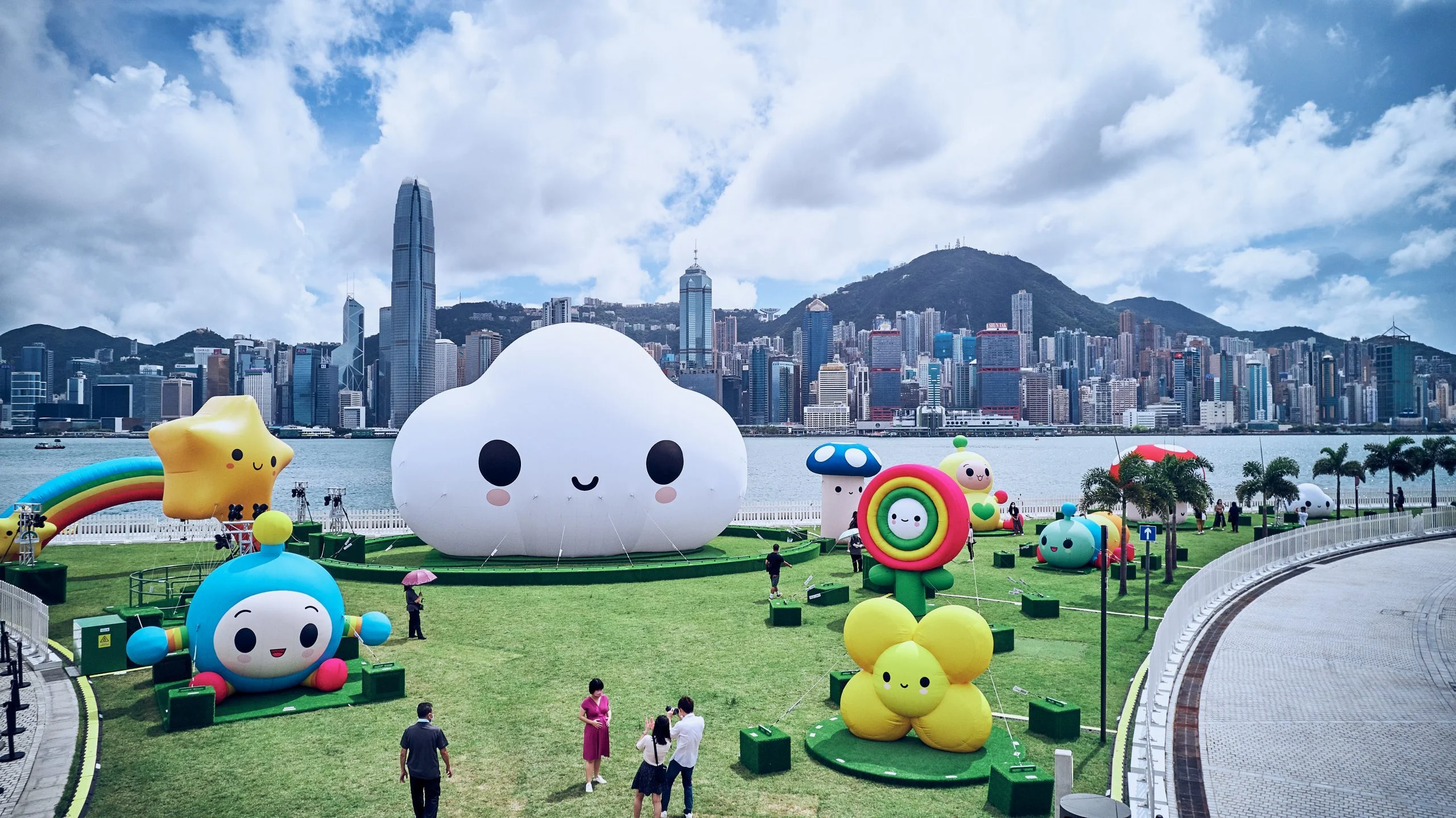
Indeed, joy is the engine behind their long history of massive inflatables, parades, and interventions in urban space — from New York to Tokyo, from Miami to London. Beyond the gallery walls, FriendsWithYou brings their art directly to the people. Their participation in public parades and events transforms urban spaces into vibrant canvases, inviting passersby to connect with art in unexpected ways. This commitment to accessibility reflects their belief that art should be a shared experience, fostering a sense of community and connection among diverse audiences.
It’s an enduring installation in a space that’s open, free, and central.

“We’re trying to return to a communion with the natural world. Not to dominate nature, but to be part of it,” said Tury. “There is no hierarchy — we’re all in this together, part of the same ecological and spiritual system.”
That philosophy is visible in the form of the clouds — simple, smiling, disarming. “You can’t help but smile back,” Sam said. “It’s part of the human condition to mimic, to reflect. That smile can shift your whole day.”
“When children engage directly with art, they don’t need to be taught — they absorb, they reflect, they create,” said Sam.
During Arcade’s visit, a school group wandered into the Forum. An organic opportunity permitted the students to rush forward and ask the artists Samuel Borkson and Arturo "Tury" Sandoval III of FriendsWithYou poignant questions, grinning skyward, laughing. Their teacher gave them space to simply absorb the art. Later, Sam recalled their questions. “They’re artists themselves. They’re thinking about what they’re feeling. These young minds — this is the generation that’s inheriting everything we’ve broken. We want to give them a way to see the world differently.”
FriendsWithYou’s work with children extends beyond the gallery. Their upcoming YouTube series, tentatively titled Happy World, will model love, care, and ecological balance rather than frenetic entertainment. “We slow down the pacing intentionally,” Sam explained. “We want it to be soothing, to reset children’s emotional capacity, to show a loving, connected world.”
In Happy World, the garden becomes a metaphor: nurturing yourself, your friends, and your environment together. This push counters modernity’s emphasis on individualism with a vision of collaborative ecosystems. Their earlier animations, like True and the Rainbow Kingdom, introduced meditation, wish-as-tool metaphors, and emotional resilience — equipping young viewers with lifelong tools.
In Coast Salish teachings — including those upheld by the Suquamish people — the natural world is alive with memory and spirit. A shape-shifting figure known as The Changer transformed animals, rivers, rocks, and clouds into their present forms, leaving behind intelligence, emotion, and ancestral presence. This worldview teaches that sky beings like clouds are not merely weather, but sentient kin — guides and companions in the ecological and spiritual system of the land. As described in regional Coastal Arts frameworks, this relational ontology sees everything as interconnected, reflective, and alive.
Within this context, Little Cloud Sky gains local resonance: its smiling forms echo these teachings, inviting viewers to see the sky itself as a source of companionship, care, and wisdom. Though FriendsWithYou draws from global traditions, in Seattle, their work floats within a lineage of place-based belonging and Indigenous ecological wisdom long honored by institutions such as the Suquamish Museum, shared in partnership through research and community stewardship by the Burke Museum, and now thoughtfully reflected in the Seattle Art Museum’s evolving public practice.
“Clouds are portals,” Sam said. “They’re the space between heaven and earth. That’s true in so many cosmologies. Jung, Joseph Campbell, Disney, Miyazaki, Jodorowsky — these are all parts of our constellation.”
Tury emphasized, “We’re inspired by Indigenous and Eastern philosophies too — especially Zen Buddhism. There’s this quiet, arresting quality in Zen — being at peace in your natural state, not focusing on suffering but on harmony. That’s radically different from Western monumental traditions that center pain or dominance. We are embracing the monument as ease and belonging.”
The artists drew deeply from spiritual, mythological, and philosophical sources. Sam emphasized the Jungian analytical psychology of individuation within common ancestral consciousness. Joseph Campbell’s monomyth, integrated into popular mass culture, serves as the basis for FriendsWithYou, and also for Star Wars, The Matrix, Batman, and encourages communities to “follow your bliss” through works like The Ecstasy of Being, Hero with a Thousand Faces, and Man and Myth. Jodorowsky’s psychomagic aims to heal psychological wounds suffered in life. This therapy is based on the belief that the performance of certain acts can directly act upon the unconscious mind, releasing it from a series of traumas, some of which practitioners of the therapy believe are passed down from generation to generation. Monomyths, ancestral memory, and psychomagic serve as the cosmological framework behind their materiality and aesthetic.
Since our earlier conversation, the artists’ philosophical touchstones have clarified and evolved. Tury’s “true north” has shifted toward the work of René Girard, particularly his mimetic theory and analysis of the scapegoat mechanism as a foundational structure in human culture. Girard’s ideas, which explore how desire is imitated and how societies unify by targeting scapegoats, have deepened FriendsWithYou’s commitment to resisting division and fostering unity. “I’m interested in removing ourselves from the scapegoat dynamic,” Tury said. “That’s part of the problem we’re all dealing with right now.”
Sam, meanwhile, sees kinship with Osamu Tezuka, the “God of Manga,” whose accessible, child-friendly worlds carried moral, ecological, and philosophical weight. “When children engage directly with art, they don’t need to be told — they absorb, reflect, and create,” Sam said.
They refer to this theoretical process as “emotional infrastructure” — the idea that a piece of art, a public space, or even a single image can hold emotional weight, scaffolding the psyche during times of global exhaustion. “We’re in a trauma-heavy time,” Sam said. “But that’s why joy is even more important. It’s not frivolous. It’s essential.”
“Everything in nature is working for us and with us,” Tury added. “It’s not against us. We’re just like a flower, a tree, a leaf. The more we remember that, the more we heal. This work is a symbol of that reconnection.”
For Diaz, Little Cloud Sky is part of a larger arc of museum transformation. “This is just one step,” he said. “We’ve been in grim, upsetting times. Art can address that explicitly, like Ai Weiwei does. But art can also address it with softness. With joy. With light.”
The installation sits at the intersection of that vision: healing through lightness, softness, welcome. “There’s no admission charge to be here,” Diaz reminded. “You don’t have to be a member. You don’t have to know art history. This is for the people of Seattle. This is about reclaiming public space as emotional space.”
SAM plans to integrate more art into its Forum and public spaces, including sound pieces, expanded programming, and a reimagining of the South Hall. But perhaps nothing will replace the quiet, disarming magic of Little Cloud Sky — not as an artwork to decipher, but as a feeling to dwell in.
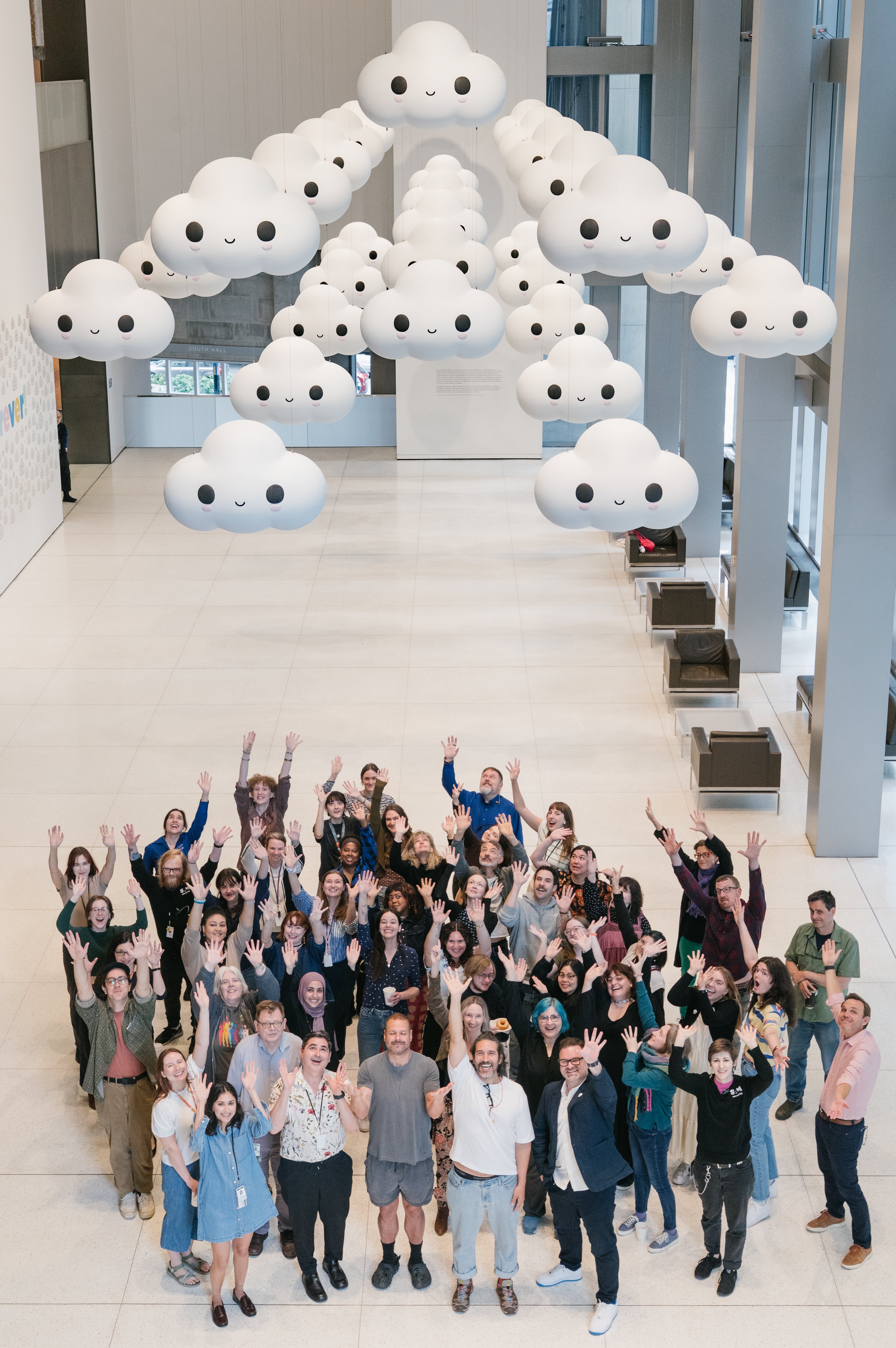
Little Cloud Sky's emphasis on the importance of the natural world resonates deeply in Seattle, a city that prides itself on its environmental consciousness. Their work serves as a reminder that we are all interconnected and that our well-being depends on the health of the planet. By creating art that celebrates nature, they invite us to become more mindful of our impact on the environment and to take action to protect it.
“We are all part of this same thing,” said Tury. “This earth. This sky. These clouds. We’re not different from them. We’re just like a flower or a tree. And we have to nurture that.”
SAM continues to expand its vision for the Forum and public spaces–introducing new furnishings, sound works, expanded Mind and Body programming, and a reimagining of the South Hall. While the Seattle Art Museum’s programming and design continue to grow, Little Cloud Sky continues to hold a quiet, disarming magic at the heart of the Forum.
In a city known for its vibrant arts scene and deep connection to the natural world, Little Cloud Sky's work strikes a resonant chord. Their emphasis on interconnectedness and environmental awareness aligns with Seattle's progressive values and its commitment to sustainability. By creating art that celebrates nature and fosters a sense of community, they contribute to the city's unique identity as a place where urban life and natural beauty coexist in harmony.


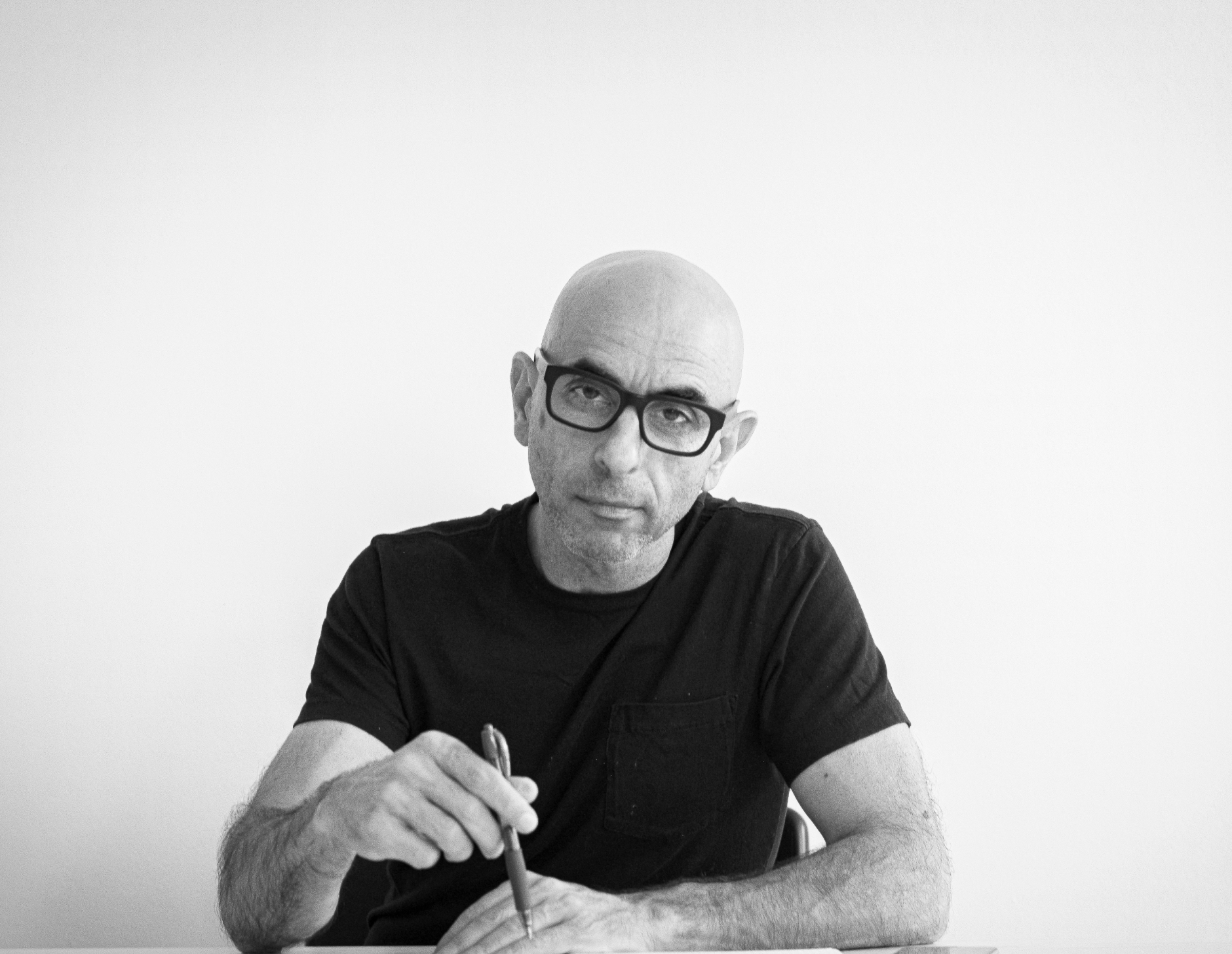
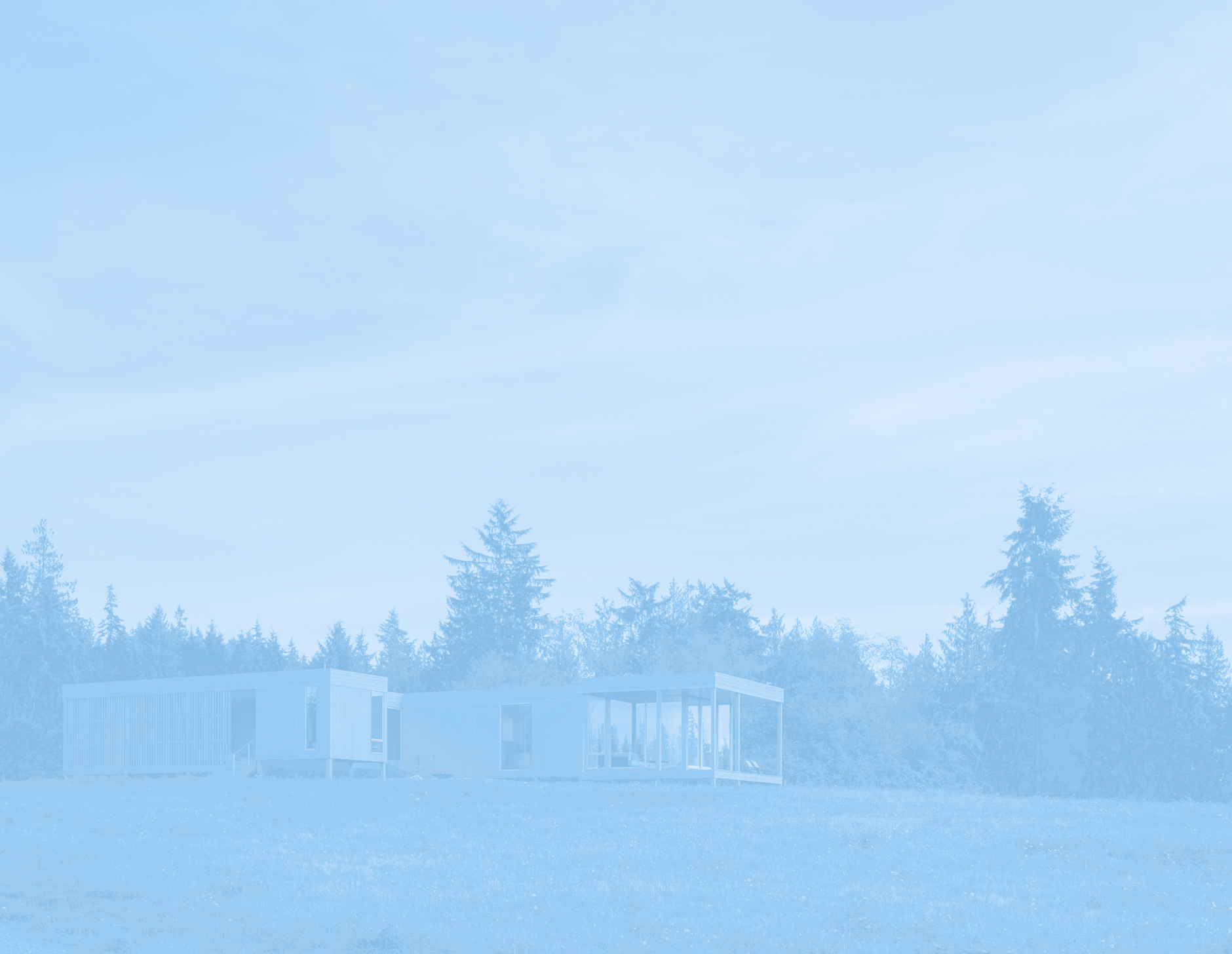
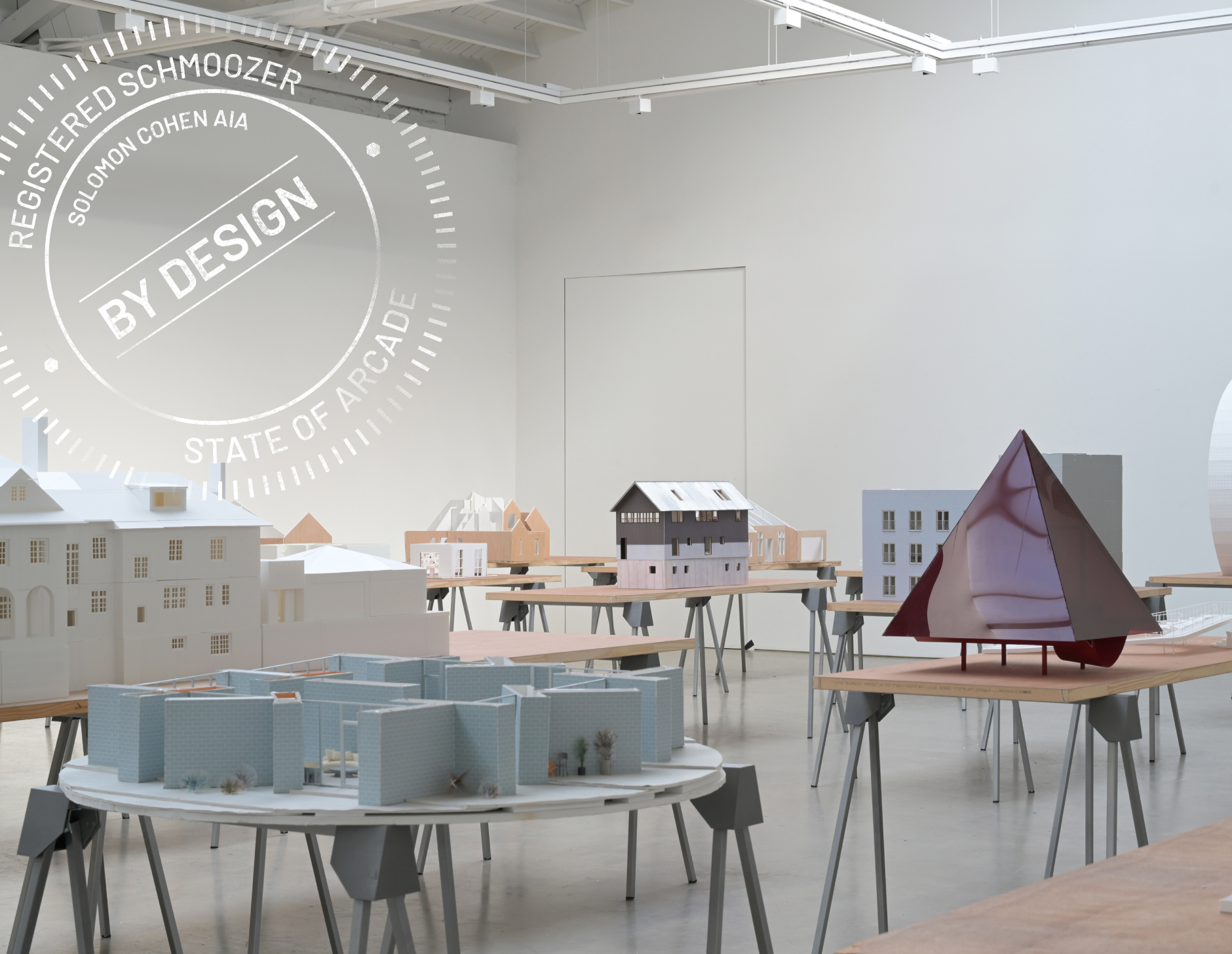

.jpg)

.jpg)

